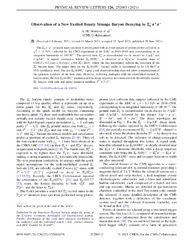Observation of a new excited beauty strange baryon decaying to Ξb- π+π-
| dc.contributor.author | Sirunyan, A. M. | |
| dc.contributor.author | Işıldak, Bora | |
| dc.date.accessioned | 2023-05-10T10:43:50Z | |
| dc.date.available | 2023-05-10T10:43:50Z | |
| dc.date.issued | 2021-06-25 | |
| dc.identifier.issn | 0031-9007 | en_US |
| dc.identifier.uri | http://hdl.handle.net/10679/8233 | |
| dc.identifier.uri | https://journals.aps.org/prl/abstract/10.1103/PhysRevLett.126.252003 | |
| dc.description.abstract | The Ξb-π+π- invariant mass spectrum is investigated with an event sample of proton-proton collisions at s=13 TeV, collected by the CMS experiment at the LHC in 2016-2018 and corresponding to an integrated luminosity of 140 fb-1. The ground state Ξb- is reconstructed via its decays to J/ψΞ- and J/ψΛK-. A narrow resonance, labeled Ξb(6100)-, is observed at a Ξb-π+π- invariant mass of 6100.3±0.2(stat)±0.1(syst)±0.6(Ξb-) MeV, where the last uncertainty reflects the precision of the Ξb- baryon mass. The upper limit on the Ξb(6100)- natural width is determined to be 1.9 MeV at 95% confidence level. The low Ξb(6100)- signal yield observed in data does not allow a measurement of the quantum numbers of the new state. However, following analogies with the established excited Ξc baryon states, the new Ξb(6100)- resonance and its decay sequence are consistent with the orbitally excited Ξb- baryon, with spin and parity quantum numbers JP=3/2-. | en_US |
| dc.description.sponsorship | BMBWF and FWF (Austria); FNRS and FWO (Belgium); CNPq, CAPES, FAPERJ, FAPERGS, and FAPESP (Brazil); MES (Bulgaria); CERN; CAS, MoST, and NSFC (China); COLCIENCIAS (Colombia); MSES and CSF (Croatia); RIF (Cyprus); SENESCYT (Ecuador); MoER, ERC PUT, and ERDF (Estonia); Academy of Finland, MEC, and HIP (Finland); CEA and CNR-SIN2P3 (France); BMBF, DFG, and HGF (Germany); GSRT (Greece); NKFIA (Hungary); DAE and DST (India); IPM (Iran); SFI (Ireland); INFN (Italy); MSIP and NRF (Republic of Korea); MES (Latvia); LAS (Lithuania); MOE and UM (Malaysia); BUAP, CINVESTAV, CONACYT, LNS, SEP, and UASLP-FAI (Mexico); MOS (Montenegro); MBIE (New Zealand); PAEC (Pakistan); MSHE and NSC (Poland); FCT (Portugal); JINR (Dubna); MON, RosAtom, RAS, RFBR, and NRC KI (Russia); MESTD (Serbia); SEIDI, CPAN, PCTI, and FEDER (Spain); MOSTR (Sri Lanka); Swiss Funding Agencies (Switzerland); MST (Taipei); ThEPCenter, IPST, STAR, and NSTDA (Thailand); TUBITAK and TAEK (Turkey); NASU (Ukraine); STFC (United Kingdom); and DOE and NSF (USA). Individuals have received support from the Marie Curie program and the European Research Council and Horizon 2020 Grant, Contracts No. 675440, No. 724704, No. 752730, and No. 765710 (European Union); the Leventis Foundation; the Alfred P. Sloan Foundation; the Alexander von Humboldt Foundation; the Belgian Federal Science Policy Office; the Fonds pour la Formation `a la Recherche dans l'Industrie et dans l'Agriculture (FRIA-Belgium); the Agentschap voor Innovatie door Wetenschap en Technologie (IWTBelgium); the F. R. S.-FNRS and FWO (Belgium) under the "Excellence of Science-EOS"-be.h Project No. 30820817; the Beijing Municipal Science & Technology Commission, No. Z191100007219010; the Ministry of Education, Youth and Sports (MEYS) of the Czech Republic; the Deutsche Forschungsgemeinschaft (DFG), under Germany's Excellence Strategy-EXC 2121 "Quantum Universe"-390833306, and under Project No. 400140256-GRK2497; the Lendulet ("Momentum") Program and the Janos Bolyai Research Scholarship of the Hungarian Academy of Sciences, the New National Excellence Program UNKP, the NKFIA Research Grants No. 123842, No. 123959, No. 124845, No. 124850, No. 125105, No. 128713, No. 128786, and No. 129058 (Hungary); the Council of Science and Industrial Research, India; the HOMING PLUS program of the Foundation for Polish Science, cofinanced from European Union, Regional Development Fund, the Mobility Plus program of the Ministry of Science and Higher Education, the National Science Center (Poland), Contracts Harmonia 2014/14/M/ST2/00428, Opus 2014/13/B/ST2/02543, 2014/15/B/ST2/03998, and 2015/19/B/ST2/02861, Sonata-bis 2012/07/E/ST2/01406; the National Priorities Research Program by Qatar National Research Fund; the Ministry of Science and Higher Education, Project No. 14.W03.31. 0026 (Russia); the Programa Estatal de Fomento de la Investigacion Cientifica y T ' ecnica de Excelencia Maria de Maeztu, Grant No. MDM-2015-0509 and the Programa Severo Ochoa del Principado de Asturias; the Thalis and Aristeia programs cofinanced by EU-ESF and the Greek NSRF; the Rachadapisek Sompot Fund for Postdoctoral Fellowship, Chulalongkorn University and the Chulalongkorn Academic into Its 2nd Century Project Advancement Project (Thailand); the Kavli Foundation; the Nvidia Corporation; the SuperMicro Corporation; the Welch Foundation, Contract No. C-1845; and the Weston Havens Foundation (USA). | |
| dc.language.iso | eng | en_US |
| dc.publisher | American Physical Society | en_US |
| dc.relation.ispartof | Physical Review Letters | |
| dc.rights | restrictedAccess | |
| dc.rights.uri | https://creativecommons.org/licenses/by/4.0/ | |
| dc.title | Observation of a new excited beauty strange baryon decaying to Ξb- π+π- | en_US |
| dc.type | Article | en_US |
| dc.description.version | Publisher version | en_US |
| dc.peerreviewed | yes | en_US |
| dc.publicationstatus | Published | en_US |
| dc.contributor.department | Özyeğin University | |
| dc.contributor.authorID | (ORCID 0000-0002-0283-5234 & YÖK ID 124605) Işıldak, Bora | |
| dc.contributor.ozuauthor | Işıldak, Bora | |
| dc.creator | The CMS Collaboration | |
| dc.identifier.volume | 126 | en_US |
| dc.identifier.issue | 25 | en_US |
| dc.identifier.wos | WOS:000669051600004 | |
| dc.identifier.doi | 10.1103/PhysRevLett.126.252003 | en_US |
| dc.identifier.scopus | SCOPUS:2-s2.0-85108915377 | |
| dc.relation.publicationcategory | Article - International Refereed Journal - Institutional Academic Staff |
Files in this item
This item appears in the following Collection(s)
Share this page




